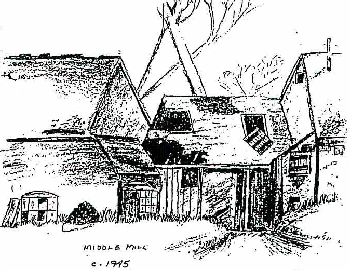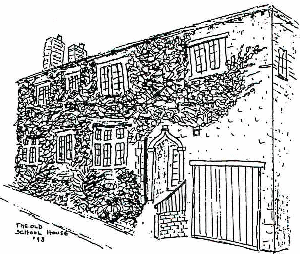WALKS AROUND HAGLEY: WALK No.5 BELBROUGHTON
DISTANCE: THREE MILES. TIME: 2 HOURS PARK IN THE LAY-BY ON THE A491 JUST BEFORE THE TRAFFIC LIGHTS AT THE TURN FOR BELBROUGHTON (OS MAP GRID REFERENCE: 936775)
- Walk down to the traffic lights, cross the road and proceed down Hartle Lane (B4188). The building on the left was once the storage building to Bell End Mill. The Mill had started as a Cornmill and became a Scythe Grinding Mill from the early twentieth century until 1949. The Mill and its dam disappeared under the road-widening scheme of 1963.

- Walk along Hartle Lane, passing a lodge to Bell Hall. The stream on your right is the Belne Brook or Rum (or Ram) Alley Brook, which has risen in the Romsley Hills. On your left you see Bell End Chapel, dating back to the twelfth century, so being one of the oldest buildings in the area. It shows work of Norman and perpendicular styles and is still in occasional use.
- Further along Hartle Lane, on the right, see Galton's Mill, sluice and now drained pool. The overshot wheel still exists but is not visible from the road. This started as Savage's Mill, corn grinding until Galtons used it for grinding gun barrels during the Napoleonic wars. In the mid-nineteenth century, Isaac Nash took it over for Scythe Grinding until 1942 when it became an engineering factory. Today it functions as an office.
- Take the first stile on the right, walk diagonally across to another stile, and turn right to the first of three twentieth century fish ponds. Look out for herons, swallows etc.

- Turn left along the pools. Soon you will see a tree-topped earth bank parallel to the path, separating the pool from a head race, which once fed water to Middle Mill. This Mill complex is immediately over the next stile, with the dam and sluice on your right and a few inconspicuous bricks from the Mill building on your left. On your right are two areas set out for water sports. Middle Mill was working until 1953 as a Plating Mill, operated by Eddie Moore, see the tail race on your left overflowing at various points back into the stream.
- Walk in a curve to the stile on the right. Continue, keeping to the left, to a stile in the trees. Follow the fence and then a hedge to another stile. Turn left. A short diversion over the stile on your right will take you up to the remains of Belbroughton Blade Mill in the grounds of Yew Tree House.
- Continue the walk and on the left of Dark Lane, at Fieldhouse Farm, is an interesting building, perhaps stables and a coach house. The overflow on the right comes from the garden of Yew Tree House where the pool of Belbroughton Corn Mill is sited.
- Reaching the main road, look to your left to see an unusual Belbroughton name plate in a garden on the right, presented by the WI in 1938. Cross the road to a narrow public footpath. Walk along it to a direction post and turn left. Across a tarmac track is the original site of the internationally famous Nash Main Works, known as Belbroughton Scythe Mill.
- Follow the narrow path past a weir made of two rows of millstones and then a rockery between two branches of the stream. This rockery is the site of another mill where coarse cloth and then corn had been processed until Nash converted to a hook and scythe grinding, glazing and polishing works. By the turn of the century it reverted to corn grinding and was demolished in 1928.
- Turn left and with the Queen's Hotel on your left, cross the road and take the road to your right up Church Hill. On the right are 18th. century Almshouses which became the village workhouse between 1825 and 1837 later licensed and known as "The New Inn" and now a private residence.

- The next building was built in 1760 as a single storey School for Boys and in 1850 an upper floor was added to provide a School for Girls. The building remained as a School until 1963, then became a private residence, and was later restored in 1979.
- Follow the road round. Holy Trinity Church is on the right. It has work of Norman and many later periods. On the wall of the Church grounds, at the junction of Church Hill and Church Road, is a tablet carved by local craftsmen which was erected by the Parishioners of Belbroughton to mark he Millennium as a tribute to the Scythemakers of Belbroughton. Isaac Nash's Great-Great Granddaughter Sallie Mahler, unveiled the tablet on 24 October 1999.
- Opposite the Church is Royden House, 19 Church Hill - built in the late 18th. century. Between 1889 and 1910 it was used as a Charity House for "waifs and strays" (i.e. an orphanage) and was known as "All Saints Home".
- Cross Church Road to see the Church Hall, an early 17th. century timber-framed Tithe Barn which was converted to a Hall for the Community in 1915. Look down the hill to see a Black and White timber-framed house, Belem Cottage. This was originally three cottages built in the 17th. century, the oldest house in the village, and well worth a diversion.
- Next to the Church Hall, going up the hill, has been the site of the Rectory from the 16th century. The present 18th century building was a Rectory until 1976.
- Walk up the hill and turn left in front of the Belbroughton First School. Continue along the footpath, pass the Tennis Courts (on your right) until you reach the main road. Go through the gate, turn right and walk back along this main road, to your starting point, looking for the timber-framed buildings and views of Bell Hall on your right.
 1
1
